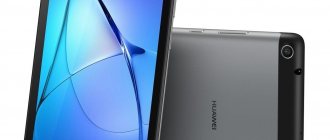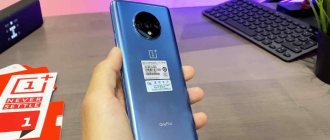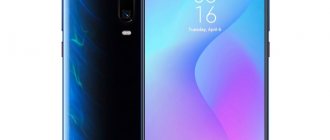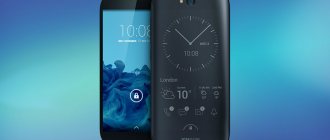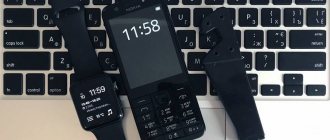No. 10 – Huawei Y6 Prime (2018)
Price: 8,190 rubles
Huawei Y6 Prime (2018) has a design that is quite typical for modern devices, but at the same time its body is assembled reliably - there are no backlashes or creaks. The screen installed in the gadget has a diagonal of 5.7 inches and a resolution of 1440x720 pixels. Looking under the hood of the Huawei Y6 Prime, you can find a Snapdragon 425 processor. Memory configuration is 2/16 GB. The sensor resolution of the main camera is 13 MP, the front camera is 8 MP. A battery with a capacity of 3000 mAh is responsible for autonomy.
Apart from the build quality, another important advantage of the smartphone is its screen. Although the resolution may seem low for such a diagonal, the image on the display is rich with sufficient levels of color rendition and contrast. Users who use their smartphone exclusively for surfing the Internet and simple games will be satisfied with the hardware of the Huawei Y6 Prime, but if you plan to play heavy games, it’s better to take a closer look at another model.
Huawei Y6 Prime
No. 9 – Xiaomi Redmi 6
Price: 11,990 rubles
Xiaomi Redmi 6 is a compact and thin smartphone with a fast fingerprint sensor. In addition, it attracts with its signature practical design from Xiaomi. The gadget is equipped with a 5.45-inch display with a resolution of 1440x720 pixels. Performance is guaranteed by the Helio P22 processor. The amount of RAM depends on the configuration - 3 or 4 GB, with built-in memory the situation is similar - 32 or 64 GB. The main camera with a dual module is 12+5 MP, the resolution of the front camera sensor is 5 MP. Battery capacity – 3000 mAh.
In addition to compactness and ergonomics, another important advantage of the gadget is the screen. For its price segment, it simply has no drawbacks - the picture is rich with a high level of color rendering, and the maximum brightness reserve is enough for comfortable use of the smartphone even under sunlight. You can also praise the hardware - the hardware configuration is not the top-end, but you can play almost any modern game with a comfortable FPS at medium settings.
Xiaomi Redmi 6
Where might fingerprint scanners be located in smartphones?
Initially, following the example of the notorious iPhone 5s, fingerprint scanners were located on the front panel. This is not surprising, because at that time there was no struggle for maximum screen area, and there was plenty of space. However, then Google decided to abandon physical buttons under the display and added the ability to use virtual analogues to Android - technology also caught up. As a result, screens replaced any additional elements from the front panels of smartphones - many companies even had to remove their logos, not to mention scanners. They were moved.
iPhone 8 and iPhone 8 Plus (Source: Pinterest)
On the front panel. Oddly enough, fingerprint scanners on the front panel can still be considered relevant. Most companies have found another place for them, but many remain true to their traditions. A striking example is the same Apple. For starters, it still makes the iPhone 8 and iPhone 8 Plus with Touch ID in the Home button below the screen. And we can end with the fact that the company will most likely retain the same location for the sensor in the iPhone 9. We are talking about the notorious continuation for the iPhone SE, which will become an inexpensive ideological successor to the “eights”.
HONOR 10i (Source: MobRev)
On the back panel. Where to move the fingerprint scanner if the entire (well, almost) front panel is already occupied by the screen? The obvious solution was to use the rear one, on which, apart from a set of cameras, additional space is not needed for anything. Today, a scanner on the back is the province of inexpensive smartphones like the HONOR 10i and the like. This approach has one main drawback - such a sensor becomes useless if the gadget is lying on a table or standing on a holder in a car. Actually, this is why in the more expensive segment they do not put a fingerprint scanner on the rear panel.
HONOR 20 (Source: SuperPlanshet)
On the side edges. For many manufacturers, the compromise between an inconvenient rear panel and a fully occupied front panel turned out to be the side edges. This solution has not become widespread, but some companies have begun to integrate fingerprint scanners into the power buttons. The role of example will again be played by the brainchild of the Huawei sub-brand - the HONOR 20 smartphone. The sensor, which can recognize patterns on the skin, is located in the power key. This turned out to be a little more convenient than the back, but it didn’t solve all the usability issues. It would be much more convenient on the front panel, but there is no room there.
(Source: Gadgetmatch)
Right on the screen. One of the first smartphones with a fingerprint sensor that was hidden directly in the screen (in fact, it is located under the matrix) was Vivo NEX. This prototype gadget was released in the summer of 2020 and surprised. However, it quickly became clear that the technology was new, not fully tested and required improvement. The response speed of such sensors has already reached a comfortable level, but there are still questions about their safety. News pops up on the Internet every now and then about hacking such solutions using 3D copies of fingers and even protective film (hello, Samsung Galaxy S10).
No. 7 – Samsung Galaxy A6+ 2020
Price: 16,590 rubles
The design of the Samsung Galaxy A6 2020 is made in accordance with the proprietary features of the company's devices, so we can say that it lacks originality. The screen has an AMOLED matrix, 5.6 inches diagonal and a resolution of 1480x720 pixels. The processor in the Samsung Galaxy A6 2020 is Exynos 7870 Octa. 3 GB of RAM are responsible for the speed of applications, and the storage can accommodate up to 32 GB of information. The resolution of the rear and front camera sensors is the same – 16 MP. Battery capacity – 3000 mAh.
Like most Samsung smartphones, the main asset of this model is the screen with an AMOLED matrix. The display is really cool - the picture on it is detailed and the colors are rich. Another object of admiration for the owner of the Samsung Galaxy A6 2020 will be the cameras - they take better pictures than most smartphones in this category, and it will not be a shame to show the results of their work on social networks.
Samsung Galaxy A6+
Samsung Galaxy Note 9 – powerful processor, wireless smartphone charging
Galaxy Note 9 are smartphones with a fingerprint, which users consider competitors of Apple gadgets. They are not inferior to the latter in price and characteristics.
Experts noted the 4,000 mAh battery, 8 GB of RAM, 10 nm processor, stereo speakers from AKG and 3-dimensional sound (Dolby Atmos technology was introduced).
Advantages of Galaxy Note 9:
- sensitive stylus;
- display with excellent color rendering;
- cameras produce clear, rich images;
- charging in 1.35 hours;
- protection from moisture.
Users liked the fast loading of objects. It was possible to increase the speed through the introduction of LTE technology, Wi-Fi, MIMO antenna (4x4).
Disadvantages of Galaxy Note 9:
- 6.4-inch display, inconvenient;
- The finger scan sensor is located on the back cover inconveniently;
- price;
- problems with updating;
- You cannot work continuously with the stylus (after 15-20 minutes they put it on the “base”).
Experts did not find it.
Samsung Galaxy Note 9 review ►
#6 – Huawei P20 Lite
Price: 17,900 rubles
Huawei P20 Lite is a compact version of the flagship Huawei P20. If the technical component has become a little more modest, then externally the smartphone still looks stylish. The screen diagonal is 5.84 inches and the resolution is 2280x1080 pixels. The heart of the gadget is the Kirin 659 processor. Memory configuration is 4/64 GB. Autonomy is guaranteed by a 3000 mAh battery. Photographers will be pleased with both the main camera with a combination of 16+2MP modules and the 16 MP front camera.
In addition to the presence of an NFC module and a wonderful fingerprint scanner that responds to touch almost instantly, the smartphone has a huge number of advantages over its opponents. The first is the front camera. Perhaps many will be surprised, but it takes great photos - selfies do not turn out blurry, and the color balance is not disturbed. The second is the screen, the image on it is always juicy and detailed. And lastly, despite the large display diagonal, the overall smartphone is compact.
Huawei P20 Lite
Fingerprint
Previously, touch sensors that provided access control could only be found in fantasy movies or science fiction novels. But the days of imagination surpassing human engineering ability are long gone—fingerprint scanners have been in use for decades! Such technologies are becoming more commonplace in the latest mobile devices and are gradually making their way into everyday life.
What are fingerprint scanners
Each person's fingerprints are unique, which is why they are successful in identifying people. It's not just law enforcement agencies that collect and maintain fingerprint databases. Many types of professions that require licensing or certification (for example, financial advisors, stockbrokers, real estate agents, teachers, doctors and nurses, security guards, contractors, etc.) use fingerprinting as a condition of employment. It is also typical to provide these identifiers when notarizing documents.
Improvements in technology have made it possible to include a fingerprint reader on the back or on the screen as another (optional) security feature for mobile devices. This identifier can be manually enabled for security (this is done in the security settings), or disabled if necessary.
The fingerprint scanner has appeared as the latest of all identification methods. There were already pin codes, pattern codes, passwords, facial recognition, location detection, iris scanning, voice recognition, reliable Bluetooth/NFC connection.
Why do you need a new security method if you can set a password?
Many are taking advantage of the new security technology for safety, convenience and a futuristic feel.
Working principle and types
The technology of how the sensors work is quite simple. The scanner captures the pattern of ridges and valleys on the finger. The information is then processed by the device's patch analysis/matching software, which compares it to the list of registered fingerprints on file. A successful match means the identification has been verified. After this, access to the data is provided.
The method for capturing fingerprint data depends on the type of scanner used:
- Optical sensor: These types of sensors basically make a photocopy of the finger. Many illuminate the finger to provide crisp line contrast as a light-sensitive image sensor or light-sensitive microchip records information to create a digital image. Many computer devices and smartphones on Android and iOS with a good camera use optical sensors for scanning.
- Capacitive sensor: Instead of light, these systems use electricity (similar to how touch screens work) to detect fingerprint patterns. As soon as your finger rests on the touch surface, the device measures the charge; ridges show a change in capacity, while valleys remain virtually unchanged. The sensor uses all this data to accurately print your fingerprints. Most smartphones with finger scanners use capacitive sensors.
- Ultrasonic Sensor: Just as bats and dolphins use echolocation to find and identify objects, ultrasonic sensors work through sound waves. The device is designed to send ultrasonic pulses and measure the number of bounces back. Ridges and valleys reflect sound differently, which is how ultrasound scanners can create a detailed 3D map of fingerprints. Ultrasonic sensors are currently being prototyped (eg by Qualcomm Technologies, Inc.) and tested for use in mobile devices such as the iPhone.
Android Pay discount cards
Pros and cons of using fingerprint scanners
Pros of using fingerprint scanners:
- Easy to lock and unlock with one finger.
- A great way to identify unique people.
- Extremely difficult to counterfeit/duplicate (compared to ID/access cards, etc.).
- Almost impossible to guess/hack (compared to PIN codes, passwords, etc.), but you can cheat, later in the article we will tell you how to do this.
- The user will not be able to forget his fingerprint (as is often the case with passwords, codes, templates, access cards, etc.).
Disadvantages of using fingerprint scanners:
- Not 100% reliable. People with the right resources, time and dedication can fool scanners with fakes and/or master prints.
- New prints cannot be obtained. You can change/replace cards, codes and passwords, but you cannot do this if someone steals your fingerprint data.
- Encryption is still questionable. Data security depends on the software/hardware manufacturer.
- A defect in the finger may make it difficult to scan successfully and prevent users from being authorized to do so. Even small flaws can create difficulties. A scratch, a bite - that's it, the sensor doesn't work.
- Microbes. Do you know how many people touched this public scanner before you did? It's better to disinfect it first.
Bitcoin withdrawal to a bank card of Russian banks
This security technology in consumer-grade electronics is still very new, so standards and protocols can be expected to be established over time. As they mature, manufacturers will be able to fine-tune and improve the quality of encryption and data protection to prevent theft or misuse.
#5 – Nokia 7 Plus
Price: 26,400 rubles
The latest Nokia smartphones do not differ too much from each other, but this cannot be called a disadvantage - after all, they are all made in a rather pleasant style. The Nokia 7 Plus has a 6-inch display with a resolution of 2160x1080 pixels. The Snapdragon 660 chipset is responsible for performance, and 4 GB of RAM helps it with this. The amount of internal memory is 64 GB. The battery has a capacity of 3800 mAh. Photo capabilities are represented by a main camera with a dual 12+13 MP module and a 16 MP front camera.
In addition to the aluminum body with copper edging, which gives the appearance of the Nokia 7 Plus seriousness and reliability, the product of the Finnish developer can also be praised for its pure Android 8.0. Among devices from Xiaomi and Huawei that are sold with a proprietary OS shell, this solution looks advantageous. A more significant and important advantage of the Nokia 7 Plus is the cameras - they work very quickly, and the quality of the images will surprise even the most experienced photography fans.
Nokia 7 Plus
Scan your fingerprint on your entire phone screen
Now the company has decided to talk in more detail about a new type of finger scanning, which can make the life of an ordinary user much more pleasant, understandable and intuitive.
In order for the entire screen to scan a fingerprint, the company proposes placing many small sensors under its surface that will work together and scan the finger , no matter where it is on the screen. It sounds simple and logical, but we must not forget that placing several coils in a wireless charger also seemed more logical. In fact, it has not yet been possible to create a platform that would charge a phone in any part of its surface.
An in-screen scanner is convenient, but when it’s only in one place, it’s a half-measure.
Huawei also notes that not only it, but also other major brands are engaged in these developments. Agree, everyone wants to gain such a competitive advantage. This is something like a system for placing the front camera under the screen. We have already written about the first such smartphone to hit the market. It should be shown on September 1 this year. Huawei is also working on such cameras, but could it be the first company that can fit both a scanner and a front-facing camera under the screen?
No. 4 – Honor 10
Price: 24,000 rubles
Another product from the popular company Huawei, Honor 10, is one step away from getting into the top three. The gadget has a 5.84-inch screen with a resolution of 2280x1080 pixels. The role of the processor was assigned to the modern Kirin 970 chipset. There are several options for the volume of RAM and internal memory: 4/6 GB and 64/128 GB, respectively. The main camera boasts a dual module – 16+24 MP, the resolution of the front sensor is 24 MP. Honor 10 also has a 3400 mAh battery.
Considering that the design of the smartphone makes you pay attention to it, and all the technical components are at the highest level, it is difficult to choose the main advantage of this model. But still, in our opinion, the main arguments in favor of buying Honor 10 are the screen and camera. The display matrix is calibrated almost perfectly - as a result, the contrast and saturation indicators are amazing, and thanks to the maximum brightness reserve, the owner will not have any problems even if he decides to use the gadget on the beach. The cameras are much better than those of the Honor 10's main competitors; they take high-quality photos, but, of course, they are far from the level of camera phones.
Honor 10
A short history of fingerprint scanners in our gadgets
The main impetus for fingerprint scanners in smartphones was the release of the iPhone 5s, which was introduced in September 2013 - almost seven years ago. Before this, this method of biometric authentication was practically not used in gadgets. However, many expected it in Apple smartphones much earlier. The company secured the corresponding sensor with a patent back in 2008, but spent five whole years to bring the technology to fruition. As a result, the fingerprint scanner was called quite simply - Touch ID. The word “simple” is very appropriate here, because before this everything was too complicated.
In general, fingerprint scanners did not initially begin to appear in smartphones. One of the first devices with this authentication method was the Acer TravelMate 739TLV laptop. Just imagine, it took him more than ten seconds to recognize a finger. Of course, during this time, a more or less experienced user could enter the computer password several times even with his eyes closed. In 2002, Hewlett Packard released the HP iPAQ H5400 pocket computer with a similar awkward sensor, which also did not cause a storm of rave reviews. Long, expensive - there were enough complaints.
Motorola Atrix 4G (Source: 24Gadget)
In more or less modern smartphones, the fingerprint scanner was one of the first to appear in the Motorola Atrix 4G. The sensor was combined with the power button and was located on the top edge of the device. It could be adjusted to fit the index finger of the right or left hand - yes, back then gadgets were small enough to reach such a control in this way. For the scanner to recognize a finger, it was not enough just to put it on it. After touching the pad, the screen would light up, and after that you also had to move the pad over it. After that, the gadget needed another half a second to read and analyze.
It would be a stretch to call such an implementation convenient - it’s too slow. It was much faster to simply press the power button and then enter the four-digit password. Moreover, such a scanner might not work if the finger was driven at the “wrong” speed. And the location was not the best - you could only try it with a standard grip of the gadget, which, as practice shows, is not always possible. In general, before the iPhone 5s with its fast and accurate Touch ID, there was nothing sensible in the Home button. It became a small revolution precisely because of its speed and convenience.
iPhone 5s (Source: Kanobu)
After the iPhone 5s, Apple updated Touch ID, making it even faster - its scanner was considered the standard, even when competitors flooded the market with similar solutions. But with the release of the iPhone X in 2017, the company made it clear that it was suspending its development. The main feature of this device was Face ID - a face scanner, which is located in the screen cutout. To this day, it remains one of the most reliable, accurate and convenient biometric authentication solutions. However, other manufacturers did not abandon the fingerprint scanner following Apple and continued its active development.
No. 3 – Xiaomi Mi Mix 2S
Price: 31,000 rubles
The bronze medalist of our rating was Xiaomi Mi Mix 2S. The smartphone was equipped with a 5.99-inch display with a resolution of 2160x1080 pixels. The role of the processor was assigned to the Snapdragon 845 chip, the amount of RAM depends on the modification - 6 or 8 GB. The situation is identical with the amount of built-in memory – 64/128/256 GB. Also, Xiaomi Mi Mix 2S has a dual main camera of 12+12 MB and a front camera of 5 MP. The battery capacity is 3400 mAh.
Among the main advantages of Xiaomi Mi Mix 2S, the frameless design stands out first of all, while it does not have the famous “bangs”, which is ambiguously accepted by users. The screen is also pleasing - the colors are rich, all parameters are at the highest level, viewing angles are maximum, the brightness range is wide - it will be comfortable both in the sun and in the complete absence of light. The hardware is top-end, you can easily run absolutely any game with the best graphics settings.
Xiaomi Mi Mix 2S
User voting
Which phone with a fingerprint and a good camera would you choose or recommend?
Apple iPhone 11
50.00 % ( 2 )
Nokia 9 Pureview
0.00 % ( 0 )
Huawei P30 Lite
0.00 % ( 0 )
OnePlus 7
0.00 % ( 0 )
Vivo NEX Dual Display Edition
0.00 % ( 0 )
Samsung A70
25.00 % ( 1 )
Lenovo Z5 Pro GT
0.00 % ( 0 )
Xiaomi Mi 9T
0.00 % ( 0 )
Oppo Reno Z Black
25.00 % ( 1 )
Honor Magic 2
0.00 % ( 0 )
#2 – LG G7 ThinQ
Price: 48,000 rubles
Silver goes to the LG G7 ThinQ, which we feel has received an unfairly low response from the market. The gadget is equipped with a display with a diagonal of 6.1 inches and a resolution of 3120x1440 pixels. The Snapdragon 845 is responsible for performance. The amount of RAM is 4 GB, and the amount of internal memory depends on the modification - 64 or 128 GB. 3000 mAh battery, dual camera on the back side – 16+16 MP and front camera 8 MP.
Like most flagships, everything here is the best. The matrix, although not AMOLED, is elegantly calibrated, so even the most demanding users will be satisfied with the image quality. The hardware is state-of-the-art and will remain relevant for another year and a half. At the moment, you can play any game on it without drawdowns or lags. The LG G7 ThinQ is not positioned as a camera phone, but even despite this, the cameras in it are quite good and better than those of most other flagships, but they cannot compete with Samsung devices in this parameter.
LG G7 ThinQ
TOP 11 best phones with a fingerprint and a good camera
| Photo | Name | Rating | Price | |
| #1 | Apple iPhone 11 | ⭐ 99 / 100 2 - votes | Find out the price | |
| #2 | Nokia 9 Pureview | ⭐ 98 / 100 | Find out the price | |
| #3 | Huawei P30 Lite | ⭐ 97 / 100 | Find out the price | |
| #4 | OnePlus 7 | ⭐ 96 / 100 | Find out the price | |
| #5 | Vivo NEX Dual Display Edition | ⭐ 95 / 100 | Find out the price | |
| #6 | Samsung A70 | ⭐ 94 / 100 1 - voice | Find out the price | |
| #7 | Lenovo Z5 Pro GT | ⭐ 93 / 100 | Find out the price | |
| #8 | Xiaomi Mi 9T | ⭐ 92 / 100 | Find out the price | |
| #9 | Oppo Reno Z Black | ⭐ 91 / 100 1 - voice | Find out the price | |
| #10 | Honor Magic 2 | ⭐ 90 / 100 | Find out the price | |
| #11 | Doogee V | ⭐ 89 / 100 | Find out the price |
Which phone with a fingerprint and a good camera would you choose or recommend?
Take the survey
No. 11. Doogee V
The smartphone runs on a 10-core processor. The device has a built-in memory of 128 GB, which can be expanded by installing microSD (however, the ability to use an additional SIM card is lost). The RAM is 6 GB in size. The model is equipped with a 6.2-inch frameless touch display with Full HD+ resolution. It has a built-in fingerprint scanner (response time 0.5 s). Android 8.0 Oreo is responsible for control.
Doogee V
The phone is powered by a 4000 mAh battery (enough for 7 hours of continuous use of the gadget), and supports wireless charging. Doogee V is equipped with a 16+13-megapixel main camera with dual LED flash, which allows you to take pictures with excellent color reproduction and image detail, and a front 13-megapixel module, which creates wonderful selfies. The phone supports Wi-Fi, Bluetooth, 4G and NFC. Both sides of the smartphone are protected by glass.
pros
- high performance;
- beautiful appearance;
- capacious battery;
- good quality of pictures.
Minuses
- The design of the phone is borrowed from Apple and Samsung.
This phone is not available for sale in our country yet.
No. 10. Honor Magic 2
The slider, equipped with an intelligent processor, is available in blue, silver and pink. It has a large screen (6.4″) with an extension of 2340×1080, covered with glass. The outer surface of the phone is treated with an oleophobic coating, so it is not afraid of fingerprints. The screen has excellent viewing angles, anti-glare ability, good color rendering, brightness and contrast.
Honor Magic 2
Android version 9 is used as the software platform. The powerful Huawei Kirin 980 processor is responsible for the performance. 6 GB RAM and 128 GB ROM are installed. The 3400 mAh battery lasts for a day of using the phone. Fast charging allows you to fully charge it in an hour and a half.
The front camera with a resolution of 16 megapixels (and two additional 2-megapixel modules) allows you to take pictures that are excellent in detail and sharpness. The quality of images from the main camera is quite average.
The phone has support for LTE, Wi-Fi, Bluetooth and NFC. A face unlock module is installed. The fingerprint scanner is located on the front, but it is quite slow.
pros
- high performance;
- excellent screen;
- good front camera;
- decent functionality.
Minuses
- there is no possibility to install a microSD memory card;
- slow operation of the fingerprint module;
- Average quality of images from the main camera.
Prices for Honor Magic 2
Honor Magic 2
No. 9. Oppo Reno Z Black
The smartphone is equipped with a large frameless display with a diagonal of 6.4″. High image quality is ensured by the AMOLED matrix, which provides excellent contrast, wide visibility and a resolution of 2340 x 1080 pixels. The 8-core MediaTek Helio P90 processor and 4 GB of RAM are responsible for high performance. The built-in memory has a capacity of 128 GB. This size is usually enough without installing an additional drive.
Oppo Reno Z Black
A dual camera of 48+5 megapixels is responsible for the excellent quality of photographs. Those who like to take selfies also have plenty of room to explore. The front camera has 32 MP. The pictures are bright, contrasty, with good detail. Oppo offers its own software for working with photos.
The phone supports LTE, Wi-Fi, Bluetooth and NFC. It can use two SIM cards (nano). A fingerprint scanner allows you to protect your phone data from unauthorized access. The battery has a capacity of 4035 mAh.
pros
- Beautiful design;
- capacious battery;
- high performance;
- good quality of pictures;
- fast working fingerprint scanner.
Minuses
- high price;
- slightly slippery screen.
Prices for Oppo Reno Z Black
Oppo Reno Z Black
No. 8. Xiaomi Mi 9T
This new product from Xiaomi immediately catches your eye with a bright display (6.4″ diagonal) and a back panel that shimmers when light hits it. The model is characterized by high performance (an 8-core Qualcomm Snapdragon 730 processor is installed) and energy efficiency. The phone has 6 GB of RAM and 64 or 128 GB ROM. There is no slot for installing an additional card.
Xiaomi Mi 9T
The battery capacity (4000 mAh) lasts for a whole day, and the charger will help you quickly restore its level completely. The three-module main camera with high resolution and dual flash allows you to take high-quality pictures even at night. The retractable panoramic selfie camera will be able to photograph a large group. This design helps leave more space for content on the screen.
The fingerprint scanner is located under the screen. Unlocking the phone is very fast. There is support for Google Pay, Wi-Fi, 4G and Bluetooth.
pros
- stylish design;
- high-quality assembly;
- frameless;
- good color rendering;
- high speed;
- good quality of photographs;
- decent sound;
- acceptable autonomy.
Minuses
- the top speaker gets clogged quickly;
- slippery body;
- a large number of unnecessary applications.
Prices for Xiaomi Mi 9T
Xiaomi Mi 9T
No. 7. Lenovo Z5 Pro GT
The slider with a frameless design and a Super AMOLED screen, clad in a carbon fiber body, is equipped with an eight-core Snapdragon 855 processor, which provides excellent performance. As for memory, the model has 8 GB of RAM and 128 or 256 GB of ROM. The gadget runs on the Android 9.0 platform.
Lenovo Z5 Pro GT
For photographs, the following are installed: a dual main module (24+15 MP) and a dual front camera (16+8 MP).
The phone is equipped with wireless interfaces: WiFi, 4G/5G, Bluetooth, navigation is carried out using GPS, Glonass, Beidou and Galileo satellites. A fingerprint scanner is built into the screen, there is Dolby Atmos sound enhancement technology, a contactless payment module and a magnetic compass. The battery has a capacity of 3350 mAh.
pros
- powerful processor;
- huge screen;
- good cameras;
- high-quality sound;
- comfortable placement in the hand.
Minuses
- flimsy design of the slider mechanism.
Lenovo Z5 Pro GT prices
Lenovo Z5 Pro GT
Video - Lenovo Z5 Pro GT Review
No. 6. Samsung A70
The smartphone stands out with a very large screen. Its diagonal is 6.7″. The unique 20:9 aspect ratio allows you to enjoy your video content. The Super AMOLED matrix will make the picture natural, rich and bright.
Samsung A70
The powerful eight-core Qualcomm Snapdragon 675 processor is able to handle the most demanding software. The phone runs on Android 9.0 Pie platform. By installing a memory card, the ROM can be expanded up to 512 GB.
A camera with three modules and artificial intelligence, with a visibility of 123 degrees, allows you to take excellent photos. It is able to recognize objects and select the desired color parameters for them, as well as detect blinking, blurring and other problems about which the smartphone owner receives a warning. The selfie camera is also capable of taking great pictures even in low visibility conditions. The battery capacity is enough for more than one day of use. Using fast charging, you can fully replenish the charge in an hour and a half.
pros
- excellent screen;
- good functionality;
- there is facial recognition;
- excellent battery;
- sufficient memory;
- good speaker.
Minuses
- the scanner does not work the first time;
- cameras allow you to take average quality pictures;
- The phone is fragile.
Prices for Samsung A70
Samsung A70
No. 5. Vivo NEX Dual Display Edition
In 2020, Vivo introduced a new smartphone equipped with dual screens. It comes in one color: blue-black shade. 91.63% of the front panel is occupied by a 6.39-inch Super AMOLED display with a resolution of 2340x1080 pixels and an aspect ratio of 19.5:9. A thin frame is visible around the perimeter. On the back there is a 5.49-inch Super AMOLED screen with Full HD resolution and an aspect ratio of 16:9. There is no front camera on the phone, as you can use the second screen to take selfies.
Vivo NEX Dual Display Edition
Both sides are covered with tempered glass with an oleophobic coating. The sides of the phone are made of aluminum alloy and plastic. The smartphone lies quite comfortably in your hand, but if you place it on a not very flat surface, you cannot avoid falling. The gadget is equipped with an eight-core Snapdragon 845 processor and Adreno 630 graphics. It runs on the Funtouch OS 4.5 operating system (based on Android 9.0 Pie).
For photography, a triple camera is used with a 12 MP module, a 2 MP sensor and a 3D TOF sensor. Security is ensured by a face authentication system and a fingerprint scanner.
pros
- good screens;
- excellent performance;
- photo of decent quality;
- large amount of memory;
- aesthetic design;
- good access protection.
Minuses
- lack of NFC;
- medium capacity battery;
- increased slipperiness;
- high price.
No. 4. OnePlus 7
The smartphone is offered in red and black colors. The 6.41″ display with FullHD+ resolution provides unprecedented image quality. Almost the entire front of the smartphone is a functional part of the display. The body of the gadget is made of aluminum alloy and the latest tempered glass.
OnePlus 7
Several versions of the smartphone are offered: 6 and 8 GB of RAM and 128/256 GB of ROM of the latest standards. The phone has the latest generation Qualcomm Snapdragon 855 processor.
The battery power is sufficient for active use throughout the day. And half an hour is enough to fully charge the smartphone. High sound quality is provided by stereo speakers with Dolby Atmos support. The phone is highly resistant to moisture, but it is not recommended to swim with it.
The model is equipped with three cameras. The main one has two modules: 48+5 MP, equipped with improved sensors and optical stabilization. It allows you to take perfectly detailed pictures even in poor lighting. The 16 MP selfie camera is complemented by a portrait mode. To unlock the phone, a fingerprint scanner is installed under the screen, which works in just 0.21 seconds. Moreover, you can touch it even with wet fingers.
The smartphone has the necessary modules: NFC, Bluetooth 5 and Wi-Fi.
pros
- lightning-fast interface operation;
- good stereo sound;
- moisture resistance;
- excellent display;
- functionality;
- durability.
Minuses
Disadvantages include high cost and possible problems with components if the device fails.
OnePlus 7 prices
OnePlus 7
No. 3. Huawei P30 Lite
The thin body and 3D glass back make the phone easy to hold and use with one hand. It is available in three shades, including gradient.
Huawei P30 Lite
A large amount of memory provides freedom of action (4 GB of RAM and 128 GB of ROM). The phone runs on the Android 9 platform. High performance is provided by the powerful Kirin 710 processor.
The smartphone is equipped with a wide 6.15-inch frameless display with FHD+ resolution. A mode that reduces eye strain during prolonged use of the gadget helps protect your eyes.
The main camera has three modules: 24 MP (wide-angle lens) + 8 MP (ultra-wide-angle lens) + 2 MP (bokeh lens), it is able to recognize 22 operating scenarios. The front camera with artificial intelligence is able to select the appropriate mode from 8 categories.
pros
- ergonomics;
- high speed;
- excellent screen;
- decent cameras;
- stylish appearance;
- good response speed of the fingerprint scanner.
Minuses
- not very loud speaker;
- weak battery.
Prices for Huawei P30 Lite
Huawei P30 Lite
No. 2. Nokia 9 Pureview
The Nokia 9 PureView smartphone received the Good Design Award 2019 in the Electronics category. This is a beautiful and tactilely pleasant gadget. It has an aluminum frame and glass on the front and back.
Nokia 9 Pureview
The phone has a Qualcomm Snapdragon 845 processor. The software platform uses Android OS version 9. The RAM capacity is 6 GB, the internal memory is 128 GB. You cannot install a memory card in a smartphone, but the available ROM size is usually sufficient. The smartphone has a relatively small battery capacity (3300 mAh), but its charge lasts for a long time.
The front camera takes pictures with decent detail. The rear camera consists of five modules (two color and three monochrome). It captures 10 times more light and the image has greater depth. In camera mode, the smartphone takes 5 pictures at a time, and then compiles them into one frame. This takes approximately 8 seconds.
Important! Photos in jpeg format are not amazing. You can get a much more interesting result from Raw files with manual processing.
The phone supports LTE-A networks, as well as Wi-Fi, Bluetooth and NFC. The navigation module works with GPS, Glonass, Beidou and Galileo. Satellites are detected in a couple of seconds. Positioning accuracy is excellent. The speaker produces very clear and spacious sound.
pros
- luxurious design;
- quality materials;
- great screen:
- powerful platform;
- the opportunity to get interesting photographs;
- no overheating.
Minuses
- no 3.5 mm jack;
- there is no memory card slot;
- there have been cases of scanner illegibility;
- no FM radio;
- high price.
Prices for Nokia 9 Pureview
Nokia 9 Pureview
No. 1. Apple iPhone 11
The phone comes in six shades: black, green, yellow, purple, red and white. The front panel is entirely occupied by the display. It has excellent color rendering. The oleophobic coating ensures the surface is resistant to fingerprints.
Apple iPhone 11
The A13 Bionic processor is powerful and energy efficient. The smartphone runs on the iOS 13 platform. The camera, consisting of two modules, allows you to take high-quality pictures, including panoramic ones. She is able to recognize people and process them differently than the rest of the picture. Photos of excellent quality are obtained even in poor lighting. The phone can shoot 4K videos at 60fps.
The facial recognition system provides data security even better than a fingerprint scanner. One glance at the screen allows you to log into the desired application or account, as well as make purchases.
The smartphone is highly resistant to water. It can withstand immersion of two meters for half an hour. The model supports wireless charging. The Apple iPhone 11 can accommodate two SIM cards: nano and eSIM.
pros
- functionality;
- high speed;
- no problems with updates;
- excellent quality photos;
- Beautiful design;
- presence of a facial recognition system.
Minuses
The disadvantages of the model include its high cost.
Table. Comparison of smartphone models with a fingerprint and an excellent camera.
| Model | Screen size, " | Memory (ROM, RAM), GB | Cameras, MP | Battery, mAh |
| Doogee V | 6,2 | 128, 6 | 16+13, 13 | 4000 |
| Honor Magic 2 | 6,4 | 128, 6 | 24+16+16, 16+2 | 3400 |
| Oppo Reno Z Black | 6,4 | 128, 4 | 48+5, 32 | 4035 |
| Xiaomi Mi 9T | 6,4 | 128/64, 6 | 48+13+8, 20 | 4000 |
| Lenovo Z5 Pro GT | 6,4 | 256/128, 8 | 25+15, 16+8 | 3350 |
| OnePlus 7 | 6,41 | 256/128, 6/8 | 48+5, 16 | 3700 |
| Huawei P30 Lite | 6,15 | 128, 4 | 24+8+2, 32 | 3340 |
| Samsung A70 | 6,7 | 128, 6 | 12x5, 20 | 3320 |
| Apple iPhone 11 | 6,1 | 64/128/256, 4 | 12+12, 12 | 3110 |
| Vivo NEX Dual Display | 6,39/5,49 | 128, 10 | 12+2+3D TOF | 3500 |
There are many reliable and functional phones with a fingerprint scanner. When choosing a gadget, you need to take into account the purpose of purchase, personal preferences and financial capabilities.
Video - TOP 5 smartphones with an in-screen fingerprint scanner
#1 – HTC U12 Plus
Price: 55,000 rubles
Topping our top 10 list of the best phones with a fingerprint is the HTC U12 Plus. The smartphone is equipped with a 6-inch display with a resolution of 2880x1440 pixels. Looking under the hood, we find the top-end Snapdragon 845 processor, which is widely used in flagships. The amount of RAM is 6 GB, and the amount of internal memory depends on the configuration - 64 or 128 GB. The main camera is dual – 12+16 MP, the front camera – 8 MP. 3500 mAh battery.
HTC has been on the market for a long time, but it rarely produces truly successful gadgets and that is why it is not perceived as a competitor by Xiaomi and Huawei. The HTC U12 Plus shows that this is misleading. The main advantage of the smartphone, which led it to victory, is the main camera. The pictures turn out great and if you blog on Instagram or just love photography, then the HTC U12 Plus is what you need.
HTC U12 Plus
Xiaomi Redmi Note 7 – high quality photos and performance
For those who are looking for a budget device for active communication, watching movies, photos, experts recommend buying this particular model. It has a 6.3-inch IPS display.
In pictures with a resolution of 2340x1080 pixels, the smallest details are visible. There is no need to strain your eyes. Buyers will also be pleased with the reasonable price of a smartphone with a fingerprint, Bluetooth 5.0, a 4,000 mAh battery, and an 8-core processor.
Phone advantages:
- glass-framed design with rounded corners;
- productivity, multitasking;
- battery charging within 1.5 hours (Qualcomm Quick Charge 4 option);
- useful options including A-GPS technology;
- Adreno 512 (powerful video processor, frequency 850 MHz);
- cameras 48 MP, 5 MP (rear), 13 MP (front).
It turned out to be important for buyers to use additional memory with a capacity of 256 GB with a built-in card of 64 GB.
But experts noted the option to optimize power consumption in accordance with specified operations; processor core frequencies are 2.2 GHz, 1.8 GHz.
Cons of Redmi Note 7:
- price;
- The camera sensor slows down, problems with pictures.
Experts noted the glass case as a disadvantage. The material creates a number of inconveniences - it slips in the hand, you need to be careful when handling it with wet hands, it is fragile.

